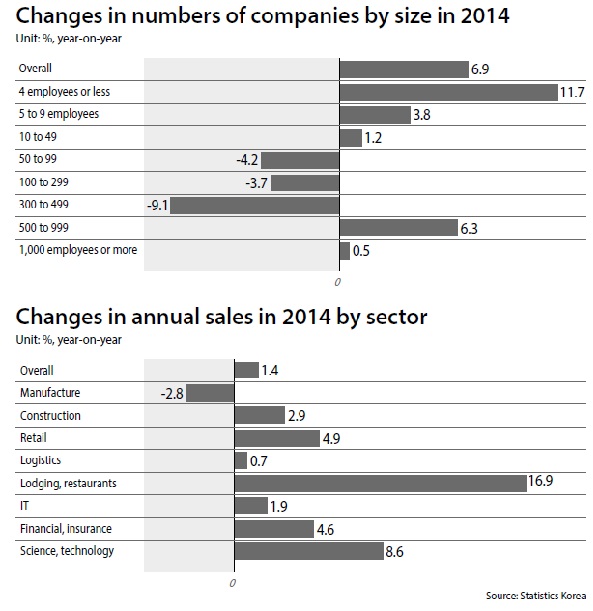Midsize manufacturers hit in 2014

According to the data released Friday, manufacturers overall saw their annual sales shrink 2.8 percent compared to 2013, when they grew 0.9 percent year-on-year.
“The overall industrial economy grew slightly despite the sinking of the Sewel ferry, but manufacturing was the only sector that showed shrinkage as the global low growth trend settled last year,” said Moon Jeong-cheol, director of the administrative data management department at Statistics Korea. “It definitely has a negative impact on the overall Korean economy, as manufacturing companies account for more than 40 percent of the total private sector.”
The overall Korean private sector saw annual sales climb 1.4 percent year-on-year. The lodging and restaurant sector saw sales increase 16.9 percent, the science and technology sector by 8.6 percent and retail by 4.9 percent.
The number of midsize companies with 300 to 400 employees declined by 9.7 percent last year compared to 2013, showing a constant decline of 9.1 percent in 2013 and 3.6 percent in 2012.
More than 36 percent of midsize companies do business in manufacturing and construction.
“The sheer number of midsize companies declining may have been caused by different reasons, not only bankruptcy but also M&A cases with another midsize or large company,” Moon added.
An official at the Association of High Potential Enterprises of Korea also suggested “there are some cases in which midsize companies divided their corporate bodies in order to regain the status of small companies.”
Many midsize companies that started out small suffered from strengthened regulations and reduced government support after expanding their businesses, the official explained, and some later divide to survive.
But the forecast for the coming year for these midsize manufacturers is not bright either, mainly due to the China’s slowdown risk.
Fitch Ratings picked Korean chemical, machinery and transport equipment manufacturers to be heavily impacted by China risk next year, even though Beijing experts expect the slowdown will be gradual.
“Demand for all of these products would likely weaken,” the ratings firm wrote in its report on Friday. “Korean companies compete directly with Chinese firms, and further yuan depreciation could erode Korean export competitiveness.”
Meanwhile, the total number of private companies in Korea expanded by 6.9 percent compared to 2013, to post 541,000.
An explosive increase of 11.7 percent last year in the number of small companies with less than four employees resulted in the expansion of the overall private sector last year.
“Many retirees find themselves opening little owner-operator shops in lodging and eatery businesses, which made the data show such high growth of these two sectors,” Moon explained. “This is not a good sign for the Korean economy, either, because the retirees had to go for a small business because there was no other choice.”
The number of lodging and restaurant businesses saw the fastest growth in 2014, at19 percent year-on-year. The sectors saw annual sales rise 16.9 percent year-on-year during the same period, but net profits declined 64.6 percent.
BY KIM JI-YOON [kim.jiyoon@joongang.co.kr]










with the Korea JoongAng Daily
To write comments, please log in to one of the accounts.
Standards Board Policy (0/250자)